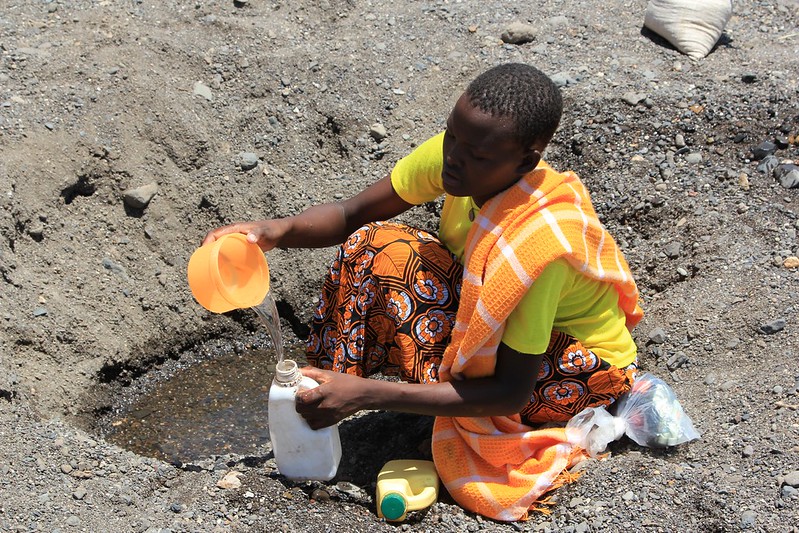Water Crisis in Turkana, Kenya
 The largest county in Kenya, Turkana, is situated in the northwestern corner of the country, bordering Ethiopia, South Sudan and Uganda. Turkana is widely recognized as “the cradle of mankind” as prolific evidence of the existence of hominids has been found here, dating back to over four million years ago. The people inhabiting this region are nomadic pastoralists, relying on the animals they raise for food and income. They move two to three times a year to avoid exhausting the land’s resources and traditionally chase the rain with their livestock.
The largest county in Kenya, Turkana, is situated in the northwestern corner of the country, bordering Ethiopia, South Sudan and Uganda. Turkana is widely recognized as “the cradle of mankind” as prolific evidence of the existence of hominids has been found here, dating back to over four million years ago. The people inhabiting this region are nomadic pastoralists, relying on the animals they raise for food and income. They move two to three times a year to avoid exhausting the land’s resources and traditionally chase the rain with their livestock.
As explained in “The Journal of African History,” published by Cambridge University, the Turkana people actively resisted and defied the occupation of their land by imperial forces of British-occupied East Africa during the 1920s and ‘30s. This resistance followed a series of conflicts with 19th century traders and explorers. During Britain’s colonization of Kenya, the Turkana region was largely left untouched. In addition to the people’s opposition to British rule, the arid climate was unfavorable to colonizers and deemed without value to anyone besides the Turkana people themselves.
Effects of a Long-Lasting Drought
Droughts have been well documented in the Turkana region of Kenya since the 1960s, projected to occur every five years. However, droughts have become an annual occurrence since the 1990s. The most recent drought began in 2020 and had killed an estimated 439,400 livestock by mid-2022. Considering the importance of livestock in this region, a crisis of hunger and water scarcity has catapulted conflicts over vital resources between pastoralists.
Vegetation cannot withstand the extreme temperatures of the desert and livestock is unavailable to slaughter or sell, positioning Turkana’s residents in a threatening situation. According to the Rockefeller Foundation, 60% of Turkana’s population is experiencing acute hunger and food insecurity, which places their lives in immediate danger if food cannot be accessed and consumed. It is not uncommon for people to subsist on local fruit trees and insects.
The Impacts of Corruption
Most of the Turkana people rely on boreholes constructed by the government or development organizations. According to the Water, Peace and Security report, water in Kenya is drilled by the government and handed down to elected water user officials who regulate the use of the water points. A combination of poor borehole management and limited rainfall has lowered the water table of wells, exacerbating the water crisis in Turkana. People often travel long distances to access these points of water, which are often high in salinity and low in water quantity. It is not uncommon for locals to climb into these wells to access water. These people are subject to extreme danger, risking falling or getting trapped below the Earth’s surface, as these wells may reach hundreds of feet deep.
In addition to these challenges, water cartels, known as Nakanas, are prevalent. Though water is ideally managed by regional committees, these cartels regularly redirect water to themselves for sale, preventing people from accessing water points. Influential businessmen and politicians also guard access to boreholes, illegally diverting water for their benefit.
Scare Resources Drive Conflict
The largest permanent desert lake in the world, Lake Turkana is at the fingertips of Northern Kenyans. The river stretches into Southwestern Ethiopia, feeding into the Omo River. The Omo River is subject to rising water levels due to deforestation and erratic rainfall in Ethiopia. Overflow from the Omo permeates Lake Turkana, altering the salinity of the water and thus changing breeding patterns among fish. Fishing communities have been forced to migrate to new areas to sustain their livelihoods, creating conflicts between the Turkana people and those residing along Ethiopia’s border. Intercommunal conflicts along the Turkana-West Pokot and Samburu-Baringo borders also exist as tribes compete over scarce resources.
Amid the water crisis in Turkana, multiple organizations are committed to improving the lives of those impacted by the drought. Several teams have been working on the ground to improve the food and water security of the population.
Keep IT Cool
A Google-backed startup based in Nairobi, known as Keep IT Cool, is transforming the food industry in Northern Kenya. The organization operates as a decentralized cold-chain company and food distributor. Keep IT Cool serves Turkana’s pastoralists by providing fisherfolk with reliable transportation and freezers to prevent spoilage during the transport to Nairobi. To help fisherfolk support themselves and their families, the company also pays 20-30 more Kenyan shillings per kilogram of fish than the local asking price.
WaterCredit Initiative
Water.org’s WaterCredit Initiative is helping people in 11 countries access affordable loans for clean water. The organization works with in-country financial companies and water service providers to add loans for water and varying sanitation solutions to their businesses. Water.org has been working to tackle the water crisis in Turkana and other regions throughout Kenya since 2005. The initiative has successfully provided 6.6 million people access to clean water and sanitation.
– Sophia Loizos
Photo: Flickr
